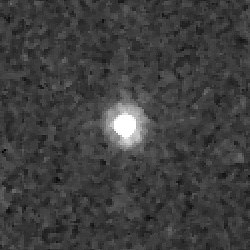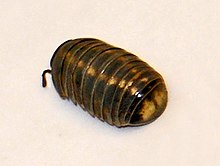(84922) 2003 VS2
(84922) 2003 VS2 2005년에 찍은 2003 VS 허블 우주 망원경2 이미지 | |
| 디스커버리[2] | |
|---|---|
| 검색 대상 | 깔끔한(644) |
| 발견일자 | 2003년[1] 11월 14일 |
| 지정 | |
| (84922) 2003 VS2 | |
| 없는 | |
| 플루티노[3][4] | |
| 궤도 특성[1][3] | |
| 2016년 1월 13일 (JD 2457400.5) | |
| 불확실성 매개변수 3 | |
| 관측호 | 8830일(24.18년) |
| 가장 빠른 사전 검색 날짜 | 1991년 9월 17일 |
| 압헬리온 | 42.413 AU(6.3449Tm) |
| 페리헬리온 | 36.456 AU(5.4537 Tm) |
| 39.435 AU(5.8994Tm) | |
| 편심성 | 0.075539 |
| 247.64 yr (90451.3 d) | |
평균 궤도 속도 | 4.75km/s |
| 15.535° | |
| 0° 0 14m.328s/일 | |
| 기울기 | 14.777° |
| 302.792° | |
| 114.317° | |
| 물리적 특성 | |
| 치수 | (627.6+14.2 −14.2) × (531+17.6 −19.6) × (494.6+53.2 −87.2) km[5] |
평균 지름 | |
평균 밀도 | 1.4+1.0 −0.3 g/cm3[5] |
| 7.4175285±0.00001 h[7] | |
| 7.41±0.02h[8] | |
| 0.131+0.024 −0.013[5] | |
| 온도 | ≈44 K |
| 19.7[9] | |
(84922) 2003 VS는2 2003년 11월 14일 근지구 소행성 추적 프로그램에 의해 발견된 넵투니아 횡단 물체다.[2]명왕성과 마찬가지로 해왕성과[3][4] 2:3 궤도공명 상태에 있고 따라서 플루티노다.빛의 곡선을 분석해 보면 왜성이 아니라는 것을 알 수 있다.[10]
궤도 및 회전
명왕성과 마찬가지로 (84922) 2003 VS도2 명왕성 궤도보다 기울기가 적고 편심도 현저히 낮지만 해왕성과 함께 3:2 평균 운동 공진에 잠겨 있다.[1]
(84922) 2003 VS는2 0.21±0.01의 유의미한 광원 진폭을 가지고 있다.회전 기간의 가장 가능성이 높은 값은 7.41±0.02 h이다.[8]
물리적 특성
(84922) 2003 VS는2 적색 표면이 적당히 적색이고 적색 색지수는 B-V=0.93, V-R=0.59이다.[11]그것의 기하학적 알베도는 약 0.13이다.[5]
2007년에 그것의 지름은 처음에 스피처 우주 망원경에 의해 725±200 km로 추정되었다.[12]그러나 2012년 허셜 우주망원경 신규 관측 이후 523.0+35.1~34
.4km로 줄었다.[6]2019년, 2003년2 VS는 2013년과 2014년에 발생한 항성 발암에 근거하여 타원형인 것으로 밝혀졌는데,[5] 이 발암에서 도출된 광선 곡선은 이 플루티노가 정수 평형 상태에 있지 않아 왜성이 아님을 시사한다.[13]2003 VS의2 치수는 627.6 km × 531 km × 494.6 km로 추정되며 부피 등가 직경 548.3+29.5-44
.6 km이다.[5] 2003 VS는2 그 질량을 직접 결정하는 데 사용할 수 있는 알려진 위성이 없지만 중간 크기 TNO의 전형적인 1 g/cm의3 밀도를 가정하면 약 7.5×1019 kg의 질량 추정치를 제공한다.[14]
참고 항목
- 같은 날(2003년 11월 14일) 발견된 또 다른 큰 넵투니아 횡단 물체 세드나.
참조
- ^ a b c d "JPL Small-Body Database Browser: 84922 (2003 VS2)" (2008-02-05 last obs). Retrieved 7 April 2016.
- ^ a b Marsden, Brian G. (16 November 2003). "MPEC 2003-W02 : 2003 VS2". IAU Minor Planet Center. Harvard-Smithsonian Center for Astrophysics. Retrieved 6 January 2010.
- ^ a b c Buie, Marc W. (5 February 2008). "Orbit Fit and Astrometric record for 84922". SwRI (Space Science Department). Retrieved 23 July 2008.
- ^ a b "MPEC 2006-X45 : Distant Minor Planets". Minor Planet Center & Tamkin Foundation Computer Network. 21 December 2006. Archived from the original on 28 August 2008. Retrieved 23 July 2008.
- ^ a b c d e f g Benedetti-Rossi, Gustavo; Santos-Sanz, P.; Ortiz, J. L.; Assafin, M.; Sicardy, B.; Morales, N. (2019). "The trans-Neptunian object (84922) 2003 VS2 through stellar occultations". The Astronomical Journal. 158 (4). arXiv:1908.06645. doi:10.3847/1538-3881/ab3b05. S2CID 201070151.
- ^ a b c Mommert, Michael; Harris, A. W.; Kiss, C.; Pál, A.; Santos-Sanz, P.; Stansberry, J.; Delsanti, A.; Vilenius, E.; Müller, T. G.; Peixinho, N.; Lellouch, E.; Szalai, N.; Henry, F.; Duffard, R.; Fornasier, S.; Hartogh, P.; Mueller, M.; Ortiz, J. L.; Protopapa, S.; Rengel, M.; Thirouin, A. (May 2012). "TNOs are cool: A survey of the trans-Neptunian region—V. Physical characterization of 18 Plutinos using Herschel-PACS observations". Astronomy & Astrophysics. 541: A93. arXiv:1202.3657. Bibcode:2012A&A...541A..93M. doi:10.1051/0004-6361/201118562. S2CID 119253817.
- ^ a b Santos-Sanz, P.; Lellouch, E.; Groussin, O.; Lacerda, P.; Muller, T.G.; Ortiz, J.L.; Kiss, C.; Vilenius, E.; Stansberry, J.; Duffard, R.; Fornasier, S.; Jorda, L.; Thirouin, A. (August 2017). ""TNOs are Cool": A survey of the trans-Neptunian region XII. Thermal light curves of Haumea, 2003 VS2 and 2003 AZ84 with Herschel/PACS". Astronomy & Astrophysics. 604 (A95): 19. arXiv:1705.09117. Bibcode:2017A&A...604A..95S. doi:10.1051/0004-6361/201630354.
- ^ a b Sheppard, Scott S. (August 2007). "Light Curves of Dwarf Plutonian Planets and other Large Kuiper Belt Objects: Their Rotations, Phase Functions, and Absolute Magnitudes". The Astronomical Journal. 134 (2): 787–798. arXiv:0704.1636. Bibcode:2007AJ....134..787S. doi:10.1086/519072. S2CID 56247384.
- ^ "AstDys (84922) 2003VS2 Ephemerides". Department of Mathematics, University of Pisa, Italy. Archived from the original on 12 July 2012. Retrieved 7 December 2009.
- ^ Tancredi, Gonzalo (2009). "Physical and dynamical characteristics of icy "dwarf planets" (plutoids)". Proceedings of the International Astronomical Union Symposium S263. 5: 173–185. Bibcode:2010IAUS..263..173T. doi:10.1017/S1743921310001717. (Dwarf Planet & Plutoid 본사)
- ^ Tegler, Stephen C. (1 February 2007). "Kuiper Belt Object Magnitudes and Surface Colors". Archived from the original on 1 September 2006. Retrieved 30 December 2009.
- ^ Stansberry, John; Grundy, Will; Brown, Mike; Cruikshank, Dale; Spencer, John; Trilling, David; Margot, Jean-Luc (2008). "Physical Properties of Kuiper Belt and Centaur Objects: Constraints from Spitzer Space Telescope" (PDF). In Barucci, M. Antonietta; Boehnhardt, Hermann; Cruikshank, Dale P. (eds.). The Solar System Beyond Neptune. University of Arizona press. pp. 161–179. arXiv:astro-ph/0702538. Bibcode:2008ssbn.book..161S. ISBN 978-0-8165-2755-7.
- ^ Benedetti-Rossi, Gustavo; Santos-Sanz, Pablo; Ortiz, Jose Luis; Assafin, Marcelo; Sicardy, Bruno; Vieira-Martins, Roberto; Braga-Ribas, Felipe (2019). "Three Stellar Occultations by the Plutino Object (84922) 2003 VS2". Epsc-DPS Joint Meeting 2019. 2019: EPSC-DPS2019-435. Bibcode:2019EPSC...13..435B.
- ^ Grundy, W.M.; Noll, K.S.; Buie, M.W.; Benecchi, S.D.; Ragozzine, D.; Roe, H.G. (2019). "The mutual orbit, mass, and density of transneptunian binary Gǃkúnǁ'hòmdímà (229762 2007 UK126)". Icarus. 334: 30–38. Bibcode:2019Icar..334...30G. doi:10.1016/j.icarus.2018.12.037.






